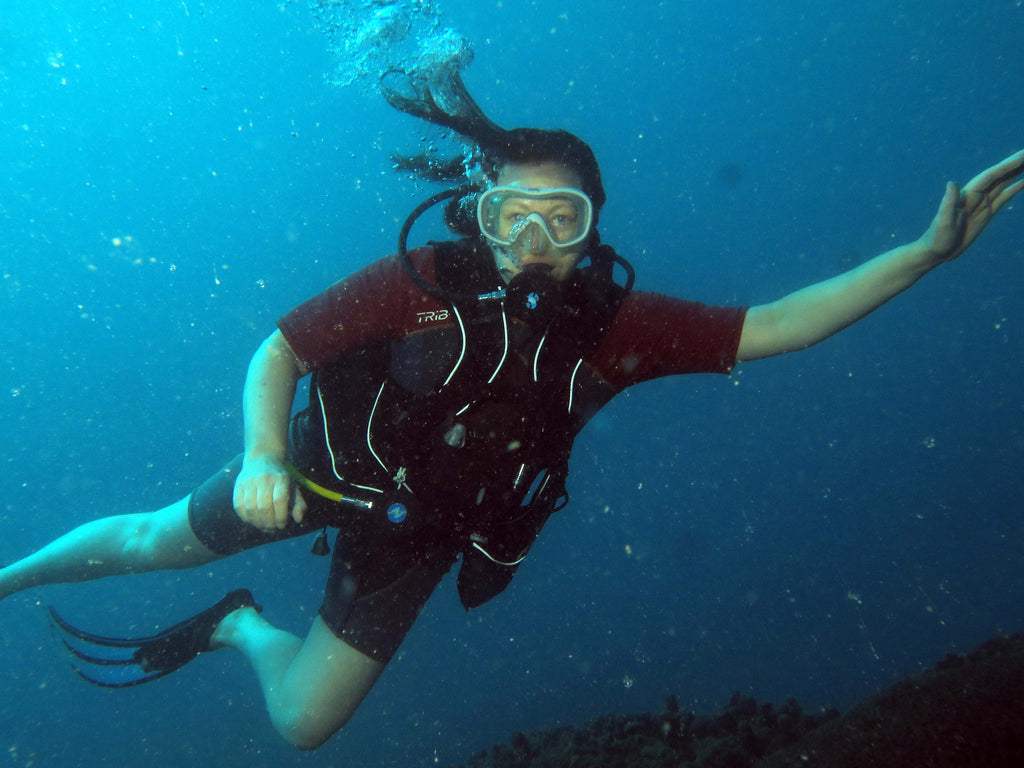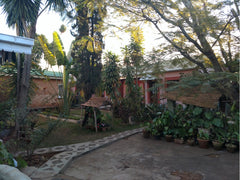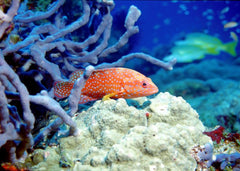Madagascar – A New Trip, New Experiences, New Gems (Part I)

The first destination on my most recent trip to Madagascar was the Island of Nosy Be, slightly to the northwest of Madagascar and very close to the coast. Before starting my gem buying, I allowed myself a few relaxing days under palm trees. On my eight-hour night flight from Amsterdam to Nairobi I met up with my travel buddy Jochen Hintze from Jentsch Minerals. We had so much to catch up on during the flight that I missed out on a bit of sleep. Luckily the Business Class Lounge in Nairobi has some couches, where I ended up crashing for three and a half of our six-hour stopover (it was supposed to be just five hours but “that is Africa” as you hear many Africans say).
We arrived in Antananarivo (called “Tana”), the capital of Madagascar, on the following day, Wednesday at 4 p.m. Tana is by far the largest city in Madagascar. It lies in the central plateau, about 1500 meters above sea level and has a very mild climate. As you fly over the 3000 mile island from the West, you will see hundreds of miles of a nearly uninhabited red mountainous region – deforested in the 1500 years since Indo-Malayans first populated the island. Your landing approach takes you over the more lush region of the central highlands with many rice paddies and rivers turned red from the earth surrounding it.
Aerial Shots of The Red Island, Madagascar


As soon as we got past the temperature and health check for yellow fever, completed our visa application and made it past the police stop, we saw Ando, Jochen’s longtime broker friend, and her daughter Maria, waiving to us from the queue. After many welcoming hugs, we took a taxi straight to hotel Mirandav, a small and private hotel not far from the airport. At the hotel, we were greeted by another familiar face, Mamavelo, one of the brokers from Antsirabe and part of Ando’s extensive family. Mamavelo had taken the local taxi-bus up to Tana to get the very first opportunity to show goods to Jochen, and Ando and Maria had brought some stuff for me – time is always too short and all prices have to be individually negotiated. Ando does a great job announcing our arrival to dozens of dealers, letting them know what we are interested in and arranging the meetings. So we spent our first two hours fresh off the plane looking at gems at a table in front of my room, shaded by palm trees; just until past nightfall at 6 p.m., when even the battery operated lantern I brought didn’t yield enough information any more. I saw several new sapphire parcels of blue-green, blue and pink shades, some nice rich dark but included aqua, a parcel of Malaya garnet ovals, as well as sphene, chrysoberyl and a lot of demantoid for me to mull over. I was too tired to make any decisions but I set aside what I liked for Ando to talk to the “proprietaries” about more realistic prices than the first quotes, which are traditionally way too high.
Reunion with Ando Antoniania, our Broker


For dinner, we went to a restaurant for Tana locals – Chez Maman - and where we were indeed the only white faces. I had some excellent salads, beef tongue with French fries, and the local beer, THB – Three Horses Beer. For the four of us, dinner and drinks came to just under $10. I tried to take some video, it was funny sitting at such a noisy street with cars honking at each other, buyers and sellers of who knows what arguing, tables tightly packed, and feeling completely out of place, just not in a bad way.
After we got back to the Mirandav and finished rearranging our suitcases so that some of them could stay at the hotel (the local airline doesn’t allow 2 pieces of luggage so one had to stay behind), I was out like a light.
Hotel Mirandav, Ivato (Near Antanarivo)



At 5 a.m., the alarm rang again so we could start the next leg of our flight. The flight to Nosy Be was scheduled for 7:30 a.m. Just as we were about to leave, at 6 a.m., there was a knock on the door. It was another broker from Antsirabe; her name is Gitte, just like my aunt, and who had taken the bus up to see us before our flight was leaving, not realizing we had an early morning flight. Jochen didn’t want her to feel bad so he let her unpack her wares right on the bed amidst the packed luggage in the dark. But we just didn’t have time (or light for that matter). Gitte was really disappointed. It’s a five hour ride on a crappy taxi bus from Antsirabe. (Luckily we were able to buy some stuff from her at a later point in the trip).
We made it to the airport at around 6:15 a.m., and already there was a long line for “Air Maybe” – the local nickname for Air Madagascar. Air Madagascar has earned this nickname for its high unreliability. Maybe it goes somewhere, and maybe not, maybe it flies on time, and maybe not. For instance, when there’s no fuel or there aren’t enough passengers booked, it doesn’t take off. Ticket prices are equally unreliable and depend on fuel costs as well as the number of passengers booked – tickets for flights within Madagascar are usually quite expensive, but despite all these disadvantages, it is a far better way to get around than driving long distances on poor and only partially paved roads!
Well, we lucked out. We weren’t on time or anything – there was not enough personnel to check us in quickly. But we did leave. Only not to Nosy Be! Literally just before takeoff the pilot announced that we were making another stop, just north of Nosy Be on the mainland, at the town of Diego Suarez / Antsiranana (that’s the former French name and the later Malagasy name). Back in the day this area was considered a hideout for Portuguese pirates. It doesn’t look very exciting there now though.
The reason, apparently, for our stop was to drop off some cargo. Another plane had engine trouble so our plane took its cargo over to Diego. None of the passengers even raised an eyebrow about the change in plans. A local Frenchman said to us “c’est normal.” So we accepted it as normal, enjoyed the view from above, and tried not to be phased by the two hour delay (late takeoff, extra hour on the plane, and a short stay in Diego where we had to all leave the plane only to sit in a tiny arrival hall with nothing in it but chairs, and then get back on).
Aerial Shots of Diego, Madagascar and Nosy Mitsio


At the airport we were met by our driver for the stay, Ando’s cousin Gael who’s father owns the Toyota Jeep we had rented, and who had made the entire two day trip by car. Gael had decided to use the occasion to visit some friends of his who live on the island. The original plan had been for Gael to pick us up at the end of the stay in Nosy Be, but he’s a fun companion and we were glad to have the car. Gael turned 30 this year, he is well educated by Madagascan standards with a degree in computer science, he’s funny, very curious about things and and enjoys driving Jochen around during his gem buying tours. I had already met Gael on my last trip, and we had a lot of interesting discussions comparing our lives.
Gael and Yvonne

The Island, as best as I can describe it, is a small slice of paradise. I had never been anywhere so tranquil and peaceful. From my reading, I ascertained that Nosy Be has over 40,000 inhabitants but it doesn’t feel at all crowded. And according to Gael’s observations, it has more white people than anywhere else in Madagascar in one place. I should qualify this remark: by my standards there were very few white people here, perhaps 1 in 100. Nosy Be probably also has the largest number of rich people in Madagascar, with perhaps the exception of Tana. The rich on Nosy Be are mostly French tourists I presume, but at our hotel – the Vanila Hotel and Spa - there were people from all over: Belgium, the Netherlands, Croatia, and a group of rich Malagasy. Generally the hotel did not seem very occupied for this August, which is not only vacation time all over the world, but winter in Madagascar with very mild days (85-90 degrees, not humid, about 70 at night). The hotel itself was fantastic: rooms were large and airy and equipped with AC and flat screen tv’s (an absolute rarity in Madagascar); the mattress made of memory foam and the food, which was largely French with some local influences, very good (think French brasserie with an Asian flair). The prawns and shrimp had very unique taste, nothing like the Thai stuff we usually get in the US, and the desserts (sadly for my waistline) were absolutely excellent. Every Saturday there is a big buffet with local Malagasy food, i.e. roasted red snapper and coconut chicken curry. And banana dessert wrapped in banana leaves, in addition to cheesecake, fresh fruits and crème caramel. For breakfast, lunch and dinner, you could order fresh pressed juices, tuck into a nice size buffet and get fresh made omelettes and French pastries.
Images of the Vanila Hotel and Spa in Nosy Be







But for me, so far, the highlight of this trip was an entirely unexpected one: I learned scuba diving! I came here expecting to do some snorkeling but Jochen convinced me to try the sport with him. Nosy Be is well known for its coral reefs located just off shore, boasting a wide variety of marine life. It turned out that there was a diving school right next door, run by a French marine biologist and his wife, Alain Benoit and Nathalie. They used to live in the Comores but according to Alain, who was our diving teacher for the duration, the coral reefs there are dying from pollution and so they relocated. Alain is also an excellent photographer by trade (see his photos here)
Unfortunately the money Alain earned through photography and writing was not sufficient, which is one reason why they founded the Sakalov Diving School. The couple also operates an Air BnB and they offer other excursions to familiarize travelers with the local flora and fauna. Alain related to us that he had co-authored an article about one of the coral reefs near Nosy-Be, explaining the extinction it faces and how to help prevent it, yet nobody seemed interested in publishing it. My own feeling is that magazines all over the world are flooded with articles about how we are managing to kill the planet.


But let’s get back to the more uplifting (or perhaps downlifting) subject of diving. I was actually a bit scared to be dependent upon a tube for breathing. You have to first get used to breathing through your mouth, and the sound of the regulator was very loud and unnerving to me. Add to that the thought that your “breathing tube” could easily pop out of your mouth if you don’t remember it’s vital importance while staring at colorful fish. But we didn’t dive very deep and there was no decompression needed – so if you panic you can just swim back up. In addition to that, I bit on my mouthpiece quite hard, so much so that I was concerned about leaving toothmarks.
Yvonne Diving near Nosy Sakatia

Our first dive took us to an exploratory six meters, the second to about 12 – a fact that I was blissfully unaware of until Alain told us at the end of the day. On day two we went down to 15 meters, and we saw a baby seahorse nesting in the wall of one of the reefs. On the final day I got my diving certificate which meant, of course, that I had to go to a diving depth of 18 meters, but not for very long.
I didn’t find it very hard to dive, but it was a little tricky to regulate your buoyancy, and my ears didn’t like the water pressure so I had to go down very slowly (imagine going up and down in an elevator very fast, you have to swallow hard or hold your nose and breathe out hard to “pop your ears”. Before each dive we got to practice some safety procedures, most of which would not likely be needed on these kinds of dives, but I appreciated them just the same. It felt quite weird taking my mouth tube out under water, letting it go and then finding it again and putting it back – or swimming over to Jochen and grabbing his backup regulator to simulate a regulator or air failure on my part. For getting a certificate, all these exercises are required. Ugh.
Weirdly enough, I never panicked during any of the dives, somehow I thought at first I’d want to go back up but then I got distracted by all those “fishes” and coral, sea cucumbers, star fish, lion fish and I don’t know what else – or yes a mantis shrimp, a very colorful animal. Some of the star fish and corals literally seemed like they “glow in the dark.” It’s a funny experience because even though you easily see it in photos online, you can’t imagine how colorful it is “down there.” And how surreal the entire experience is. In the end, I am very glad I did this and hope to do it again to see what else is hiding down there.
Gael, who had never been on a boat (and had only once been to a beach before, a year or so ago together with Jochen and his sister) came with us on our first day, and he was so delighted by the experience that we decided to sponsor a dive for him on the second day. Gael didn’t know how to swim but he bravely jumped into the shallower waters with some flippers borrowed from Nathalie. He told us later that when he saw Jochen and me paddling around in the water he thought to himself” “this can’t be that hard.” Nathalie explained that you don’t need to know how to swim in order to dive. There are just restrictions about the amount of time you can stay under (20 minutes) and how deep you can go (I believe it’s around 3 meters but it might be a bit more). Gael absolutely loved it – the experience of a lifetime he said. He even got a little diving baptism certificate!
On a sidenote: diving in Nosy Be is very cheap, about $85 for a day which includes two dives with the required rest in between and which lasts about 5 hours in total. The certificate, with the test at the end and a diving log book cost me $405.
The second highlight of our Nosy Be trip was a visit to Lemuria, a little natural park on the South East side of the island. The park houses over 25 different species of lemurs. They are so cute – I wanted to take one with me. The lemurs are tamed by park rangers. New arrivals are fenced in at first until they get used to humans. Jochen and I got to feed the lemurs with banana smeared on our open palms. One cannot pet them however. Apparently they might bite if you touch their tails because that’s their “rudder” and very important to their ability to climb and jump.
Our guide, a very exuberant young Malgash who was super excited to practice German, talked through just about all of my recordings which would otherwise have a very idyllic background of rustling trees and “chatting” lemurs. Next year they will have some big cruise ships arriving. Hopefully they don’t destroy everything.
Helle Ville, Nosy Be

In my next blog, read about my travels to the gem capital of Madagascar, Antsirabe…
